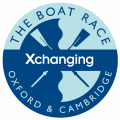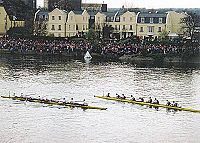The Boat Race
Modèle:Duo portail Modèle:Duo ébauche

The Boat Race est le nom d'un célèbre course d'aviron qui se court tous les ans au printemps entre les universités de Cambridge et d'Oxford sur la Tamise à Londres au Royaume-Uni. Cet événement est très populaire parmi les anciens de ces universités mais également pour les amateurs d'aviron ainsi que le grand public. Le nombre de spectateur sur les berges de la Tamise est estimé à environ à 250 000. En 2004, la retransmission télévisée a été suivie par un peu plus de 500 millions de téléspectateurs. Ceci en fait un des événements sportifs les plus suivis au monde. La première course remonte à 1829 et se court tous les ans depuis 1856 (sauf pendant les deux deux guerres mondiales).
Les membres des deux équipes sont traditionnellement surnomés les blues (les bleus) et chacun des bateaux Blue Boat, Cambridge ayant pour couleurs le bleu clair et Oxford le bleu foncé.
La course
La course se court précisement 4 miles et 374 yards soit 6 779 mètres de Putney jusqu'à Mortlake en passant par Barnes et Hammersmith. Cette course est ouverte aux huit avec barreur (i.e., 4 paires de rameurs et un barreur) et n'impose pas de limite de poids. Les bateaux doivent remonter la rivière mais la course est synchronisée avec la marée montante. Les points de départ et d'arrivée ont presque toujours été Putney et Mortlake mais à quelques occasion, la course a eu lieu :
- en 1829 à Henley-on-Thames
- de 1839 à 1842 de Westminster à Putney
- en 1846, 1856, 1862 et 1863 de Mortlake to Putney
Il y a également eu 4 courses non officielles hors de Londres durant la Seconde Guerre mondiale : en 1940 à Henley-on-Thames, en 1943 à Sandford-on-Thames, en 1944 et 1945 sur la rivière Great Ouse à Ely. Le résultats de ces courses ne sont pas retenus dans les résultats officiels.
Histoire
La tradition a débuté avec Charles Merivale, un étudiant de Cambridge et son ami Charles Wordsworth qui se trouvait à [[Université d'Oxford|Oxford. Cambridge a défié Oxford au cours d'une course et le défi a été reconduit l'annèe suivante. La tradition s'est poursuivie avec chaque année, le perdant qui relance le défi pour l'année suivante.
The race in 1877 was declared a dead heat. Legend in Oxford has it that the judge, "Honest John" Phelps, was asleep under a bush as the crews came by leading him to announce the result as a "dead heat to Oxford by four feet", but this is not borne out by contemporary reports. The Times of London said:
- "Oxford, partially disabled, were making effort after effort to hold their rapidly waning lead, while Cambridge, who, curiously enough, had settled together again, and were rowing almost as one man, were putting on a magnificent spurt at 40 strokes to the minute, with a view of catching their opponents before reaching the winning-post. Thus struggling over the remaining portion of the course, the two eights raced past the flag alongside one another, and the gun fired amid a scene of excitement rarely equalled and never exceeded. Cheers for one crew were succeeded by counter-cheers for the other, and it was impossible to tell what the result was until the Press boat backed down to the Judge and inquired the issue. John Phelps, the waterman, who officiated, replied that the noses of the boats passed the post strictly level, and that the result was a dead heat."
Bien que la course se déroule entre rameurs amateurs, chacun des rameurs devant être étudiant dans les universités respectives, l'entraînement que subit chacune des équipes est très éprouvant. Chaque équipe s'entraine en moyenne 6 jours par semaine durant les 6 mois qui précèdent la course. Such is the competitive spirit between the universities it is common for Olympic standard rowers to compete, notably including four times Olympic gold medallist Matthew Pinsent who rowed for Oxford in 1990, 1991, and 1993. Olympic Gold medallists from the 2000 Olympic games Tim Foster (Oxford 1997), Luka Grubor, and Kieran West (Cambridge 1999, 2001) have also raced for their university. Ceci a soulevé les accusations non prouvées que ces étudiants avaient été acceptés à l'université pour leurs résultats sortifs plus que pour leurs capacités intellectuelles. Ceci ne semble plus être le cas de nos jours. En 2005, l'équipe de Cambridge a par exemple aligné 4 étudiants en Ph.D. dont un docteur et un vétérinaire. Mais les accusation continuent cependant à être régulièrement relancées.

In 1987, a disagreement arose amongst the Oxford team which became known as the "Oxford mutiny." A group of talented American oarsmen were enrolled at Oxford and were prepared to compete in the race. But they became embroiled in a conflict with the team president who wanted to place himself in the boat over more qualified, internationally seasoned oarsmen. This eventually led the Americans to protest the president's abuse of power by withdrawing en mass six weeks before the race was due to start. As Gavin Stewart, the stroke and mainstay of the winning Oxford eight, stated:
- "As for the Americans starting the 'mutiny', well they didn't. The 'mutiny' happened because the squad had lost respect for Donald Macdonald as president, not least because he made it clear that he had a guaranteed seat... The spark was the decision to set aside the result of a trial between Donald and one of the Americans (which Donald lost), giving them both seats and dropping another (British) rower. The Americans began by supporting British rowers, not the other way round."
Coach Dan Topolski, who wrote a book entitled True Blue about the incident, was left with crew partially composed of oarsmen from the reserve team. To the surprise of many, the Oxford boat went on to win the race. In that year Beefeater Gin became the official sponsors of the boat race, taking over from the first sponsorship, by Ladbrokes, which dated back to 1976.
Recent years have seen especially dramatic races. In 2002, the favoured Cambridge Crew led with only a few hundred meters to go, when a Cambridge oarsman collapsed from exhaustion and Oxford rowed through to win by three-quarters of a length. They did so on the outside of the last riverbend, a feat last accomplished in the 1950s. Few observers expected the 2003 race to match the 2002 for excitement. Cambridge were substantially heavier and appeared to be the favourites. Two days prior to the race, however, the Cambridge crew suffered a collision on the river in which oarsman Wayne Pommen was injured. With a replacement in Pommen's seat, Cambridge went on to lose to a determined Oxford crew by a record margin of one foot. Cambridge gained revenge in 2004 in a race marred by dramatic clashes of oars in the early stages.
Although the heavyweight men's eights are the main draw, the two universities compete in other rowing boat races. The main boat race is preceded by a race between the two reserve crews, (called "Isis" for Oxford and "Goldie" for Cambridge). The women's eights, women's reserve eights, men's lightweight eights (and reserves), and women's lightweight eights race in the Henley Boat Races on a different day.
La course est aujourd'hui devenue une institution nationale britannique et est retransmise à la télévision chaque année. En 2005, après 66 ans d'exclicivité, la BBC a laissé les droit de retransmission à ITV. La course a été gagnée 78 fois par Cambridge et 72 par Oxford. L'édition de 2003 a vu l'arrivée la plus serrée de son histoire, Oxford devançant Cambridge d'un pied seulement (environ 30 cm=.
Préparation à la course
L'entrainement pour la course débute en septembre en même temps que l'année universitaire. Les premiers tests on lieu en novembre au Championnat britannique d'aviron en intérieur où chacune des universités envoit une vingtaine de rameurs. Les deux universités envoient également leurs équipes respectives participer à la Fours Head, une course qui se court sur la Tamise à Londres mais dans le sens inverse de la Boat Race.
En décembre, les entraîneurs de chaque universités font s'affronter deux équiques de chaque université sur le même parcours que la course réelle. On donne souvent des surnoms à ces équipes. En 2004, les deux équipes de Cambridge étaient surnommées Kara et Whakamanawa (termes Maori siginifiant force et honneur) et celles d'Oxford Cowboys and Indiens.
Durant la période de Noël, les équipes partent en camp d'entrainement à l'étranger où les équipages définitifs sont décidés. Une fois les équipes formées, elles se mesurent aux meilleurs équipes d'aviron britanniques et étrangères. (e.g. in recent years they have raced Leander, Molesey, and the German international crew). These races are only over part of the course (from Putney to Chiswick Eyot).
En cas de blessure ou de maladie, chaque universités a droit à 2 rameurs supplémentaires, appelés spare pair (paire de réserve). Dans la semaine précédant la course, week before the main event they race each other from the mile post to university stone (1 mile long). Les pesées officielles individuelles et de l'équipe ont lieur durant la dernière semaine.
Anecdotes
- En 1949, un commentaire du journaliste sportif de la BBC John Snagge est resté célèbre : I can't see who's in the lead but it's either Oxford or Cambridge. (Je ne peux pas voir qui est en tête mais c'est soit Oxford, soit Cambridge).
- Le terme Boat race est devenu si populaire que c'est un synonyme de face en Cockney rhyming slang, une forme d'argot des Cockney.
- Sur les armes du London Borough of Richmond upon Thames, sur le territoire duquel se déroule la plupart de la course, on trouve deux griffons portant des rames, une bleue clair et une bleu foncé, en référance à la course. Ces couleurs sont très rares en héraldique.These colours are highly unusual in English heraldry.
- La première femme a participer à la course a été Susan Brown, qui a barré pour Oxford en 1981.
- Certains participants à la course sont par la suite devenus célèbres : Andrew Irvine (Oxford 1923), Lord Snowdon (Cambridge 1950), Colin Moynihan (Oxford 1977) et Hugh Laurie (Cambridge 1980).
- One entertainment for spectators is the possibility of a boat sinking. This has occurred on three occasions; to the Oxford crew in 1925 and to Cambridge in 1859 and in 1978.
Résultats
- Cambridge: 78 wins
- Oxford: 72 wins
- Dead heats: 1
The 2006 race is due to start at 4.35 pm (GMT) on Sunday 2 April.
|
|
Unofficial Wartime Races
| Date | Location | Winner |
|---|---|---|
| 1940 | Henley-on-Thames | Cambridge |
| 1943 | Sandford-on-Thames | Oxford |
| 1944 | River Ouse, Ely | Oxford |
| 1945 | Unknown | Cambridge |
Statistics
- Course Record: Cambridge 1998, 16 min 19 s
- Heaviest rower: Christopher Heathcote, Oxford 1990, 17 st 5 lb (110 kg)
- Lightest rower: Alfred Higgins, Oxford 1882, 9 st 6.5 lb (60.1 kg)
- Heaviest crew: Oxford 2005, 15 st 6 lb (98 kg) average
- Tallest rower: Josh West, Cambridge 1999/2000/2001/2002, 6 ft 9.5 in (2.07 m)
- Tallest crew: Cambridge 1999, 6 ft 6.3 in (1.98 m) average
